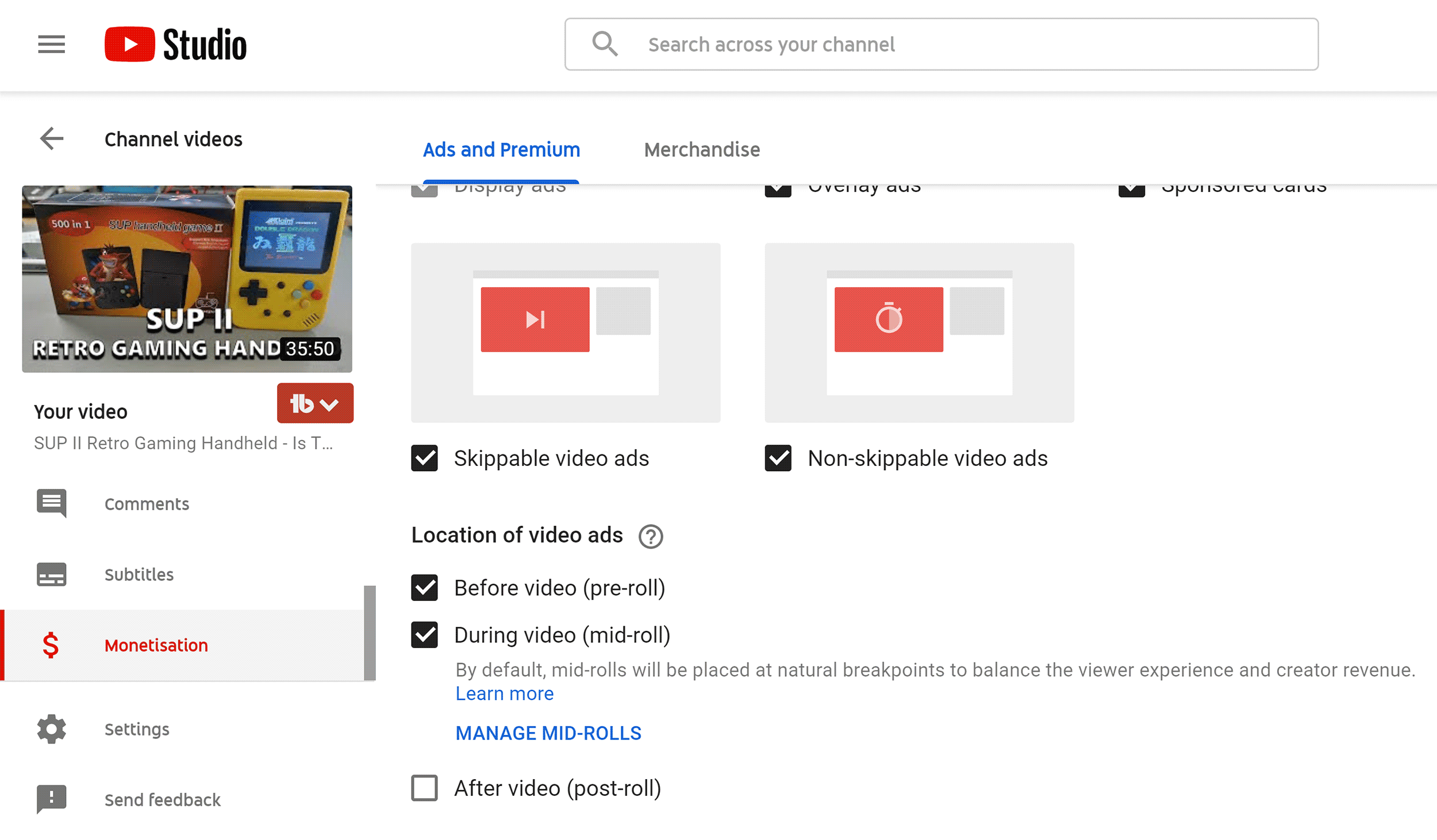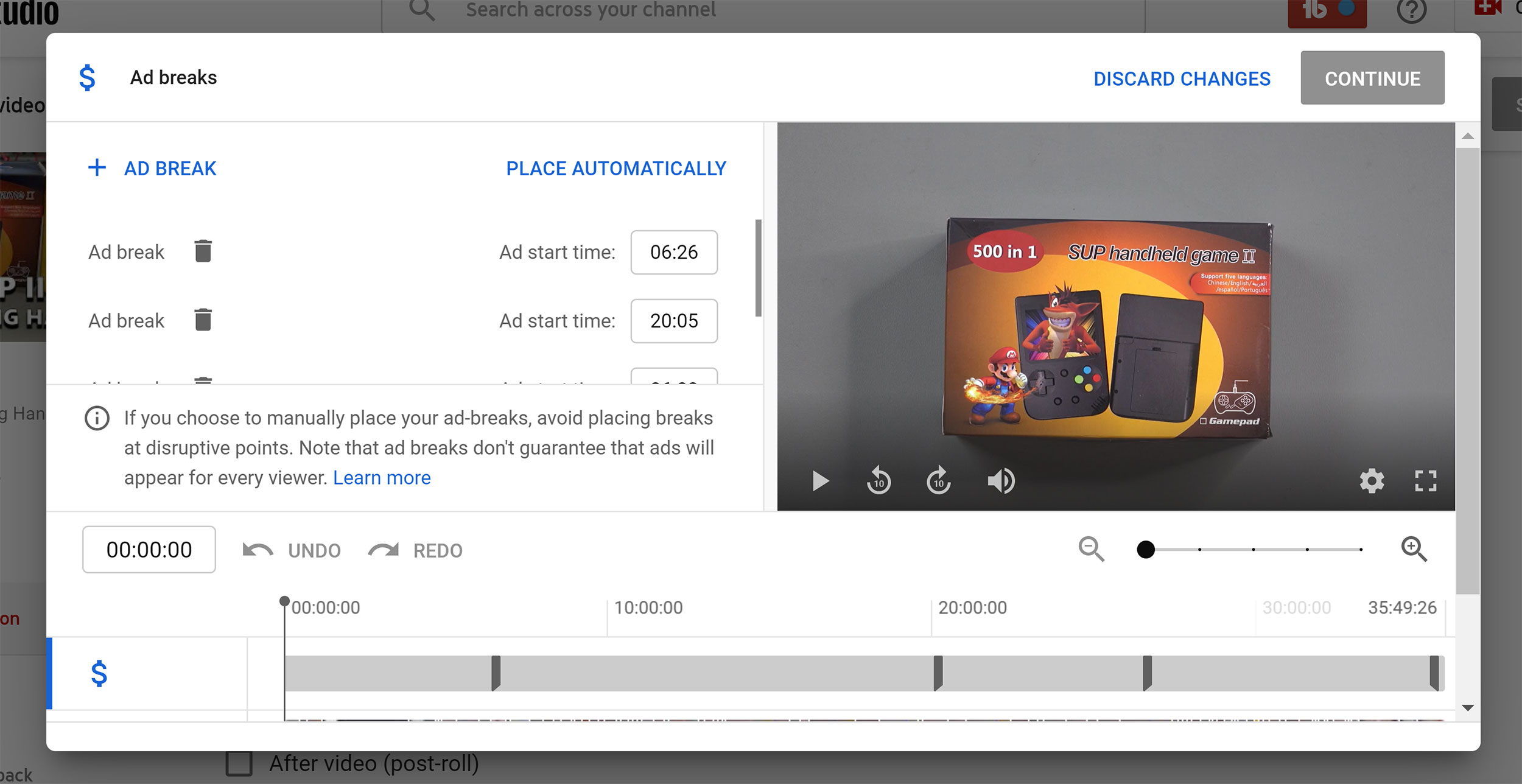YouTube refers to any advertisements during a video as a “Mid-Roll Ad Break”. On 27 July 2020, YouTube introduced some changes to mid-roll ad breaks that change the number of advertisements that are shown during YouTube videos.
Since most of my videos are longer than eight minutes, these changes effect most of my videos, but is this a good step by YouTube?
I discuss this issue in the video below.
Keep reading on to learn more about these changes.
Mid-Roll Advertisements
YouTube gives content creators various ways to insert advertisements into their videos.
The first thing they ask you is what types of ads you want to display. There are five options: Display Ads, Overlay Ads, Sponsored Cards, Skippable video ads and Non-skippable video ads. By default, all five ad types are selected, however, you can deselect any ad types you do not want to use.
YouTube also allows you to select the location of ads. You can choose to display ads before, during and after videos.
Throughout my YouTube journey, I have just displayed advertisements before a video starts and never during or after a video. As you can see from the screenshot below, YouTube are now automatically inserting mid-roll ads into my videos too.

In the video below, Google explains how mid-roll ads work.
Until YouTube implemented these new changes, I had never inserted a mid-roll ad into any of my videos, however other YouTubers have been using them for years to increase income on their website.
YouTube can insert these ads automatically or, if you prefer, you can select exactly when mid-roll advertisements are shown.

I think mid-roll ads are a great idea for long-form content such as live stream playbacks, podcast style interviews and other long videos. I do think, however, that many YouTubers are abusing the feature and inserting too many advertisements into their videos.
The Mid-Roll Ad Break Changes
Let’s talk about the exact changes YouTube has introduced.
In “Manage mid-roll ad breaks in long videos“, YouTube notes that:
- The eligibility threshold for videos to have mid-roll ads has been reduced from 10 to 8 minutes
- Mid-roll ads have been turned on by default for all eligible existing videos and set as the default for future video uploads
So you can now introduce mid-roll videos at eight minutes instead of ten, but the big change here is that mid-roll advertisements have been automatically enabled for all existing videos that are eligible.
I have reviewed many of my videos to see exactly what has changed.
As I noted earlier, I had previously enabled pre-roll ads so that the only advertisement was displayed at the start of the video. On some of my videos, the pre-roll advertisement at the start as been replaced with a mid-roll advertisement instead. In others, they have enabled an advertisement at the beginning and end of the video, but no mid-roll ads are displayed.
My initial concern about this new change was that I would overwhelm viewers with advertisements, however it appears that they are simply refining when advertisements are displayed.
And the Results Are In…
I was not initially convinced by this new change to mid-roll ads. My first thought was to disable mid-roll ads altogether, but I wanted to test it out a few weeks to see how it affected views and income.
Surprisingly, this change to mid-roll advertisements does not appear to have changed anything. I haven’t seen any dramatic change to page views or to income. On the plus side, this means the new changes are not scaring viewers away. On the down side, income is not increasing.
Whilst I make a point of not overwhelming viewers with ads, others will insert as many advertisements as possible. I do believe that it is up to every YouTuber to decide how many advertisements they insert into their videos, however I also recognise that the actions of others affect my channel too.
If YouTubers increase the number of advertisements being displayed, we may see more users use ad blocking scripts and browsers. This would lead to a decrease in revenue for everyone, not just those that are blasting users with ads.
Final Thoughts
Whilst the introduction of automatic mid-roll advertisements will not please everyone, I am pleased by the fact that YouTube are experimenting with ads as I believe there is room for improvement.
Advertisement integration will evolve over time as users viewing habits change. YouTube are keen to push users to YouTube Premium, but adoption has been slow so far. I am planning on signing up to YouTube Premium myself so that I do not see any ads when I use YouTube. Perhaps other users will do the same. We shall see.
Thanks for reading.
Kevin

